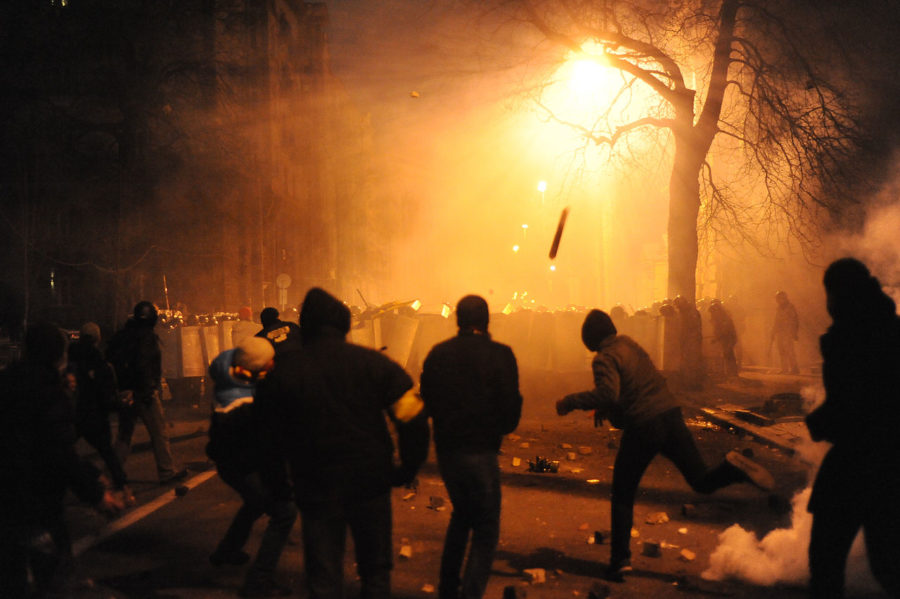
Image by Mstyslav Chernov
It’s funny how peaceful all this recent protesting for change has been. In fact, it’s so peaceful that average Americans, trying to go about their lives as normally as possible, are simply surrounded by love and feelings of euphoria.
I speak tongue-in-cheek, of course, for the exact opposite seems to be the case. The video of a Black Lives Matter protest in Utah is only the latest, high-profile example.
Video shows vehicle being surrounded by #BlackLivesMatter rioters in Provo Utah and shows protester/rioters shoot into the car multiple times as driver attempts to escape #DezNat pic.twitter.com/GYuWDiXm2o
— H O S S DezNat News Man (@NiasDiad) June 30, 2020
According to media reports, the video shows a 60-year-old local driving through Provo during a Black Lives Matter Protest. The vehicle is quickly surrounded by protesters, one of whom pulls a gun and shoots through the passenger window. The injured driver guns it, hightailing it out of the area, while protesters try to stop him, the shooter sending another bullet through the rear passenger window.
Police later arrested 33-year-old Jesse Taggart in connection with the shooting; reports indicate he also attempted further violence following the incident.
Unfortunately, we can’t chalk this up to a one-time incident by a crazed-person in a southwestern town, because many of our largest cities have experienced similar incidents of violence. Even CHAZ/CHOP, the allegedly peaceful people’s utopia in Seattle, has given way to violence. Clearing the area on July 1, officials cited violence as the main reason why the “unlawful assembly” can no longer continue:
[E]nough is enough.
The CHOP has become lawless and brutal. Four shootings—two fatal—robberies, assaults, violence and countless property crimes have occurred in this several block area.
Why all this violence? Where will it end? And how do we make sense of everything that we’re going through right now?
Philosopher Hannah Arendt pondered similar questions 50 years ago during the riots and social upheaval of the late 1960s. Writing in The New York Review of Books she noted how racial injustice drives violence, but cautioned that “Violence does not promote causes,” it only serves to “dramatize grievances and to bring them to public attention.”
Violence, Arendt theorized, often emerges in heavily bureaucratized societies. “The greater the bureaucratization of public life, the greater will be the attraction of violence,” she declares.
In a fully developed bureaucracy there is nobody left with whom one could argue, to whom one could present grievances, on whom the pressures of power could be exerted. Bureaucracy is the form of government in which everybody is deprived of political freedom, of the power to act; for the rule by Nobody is not no-rule, and where all are equally powerless we have a tyranny without a tyrant. The crucial feature in the students’ rebellions around the world is that they are directed everywhere against the ruling bureaucracy.
It’s hard to deny that we live in a bureaucratized state. Just look at the first few months of COVID-19, in which government agencies ruled the roost with predictions, models, and dictates on proper protocols for handling the virus. Or consider the many other bureaucracies which rule our lives through schools, social work, businesses, and more ordinary government regulations. Perhaps we shouldn’t be so surprised when we see society lash back at this form of “tyranny without a tyrant.”
Yet Arendt cautions that violence which lasts more than a short time can never end well:
Still, the danger of the practice of violence, even if it moves consciously within a non-extremist framework of short-term goals, will always be that the means overwhelm the end. If goals are not achieved rapidly, the result will not merely be defeat but the introduction of the practice of violence into the whole body politic. Action is irreversible, and a return to the status quo in case of defeat is always unlikely. The practice of violence, like all action, changes the world, but the most probable change is a more violent world. (Emphasis added.)
Violence and corruption have been a regular part of American life for several weeks now. The moves to disband CHAZ/CHOP because of this violence show that some leaders are beginning to put their feet down and stand up for law and order, but will such a trend continue?
If we want to live in a violent society, then according to Arendt, we should just continue the cycle we’ve practiced for the last few weeks. But if we want to once again be a peaceful, productive society, working for the good of our families, friends, and communities, we need to stand against the violence before it’s too late to turn back.
The post ‘Tyranny Without a Tyrant’: Hannah Arendt on the Root and Growth of Violence appeared first on Sovereign Nations.
– Sovereign Nations
